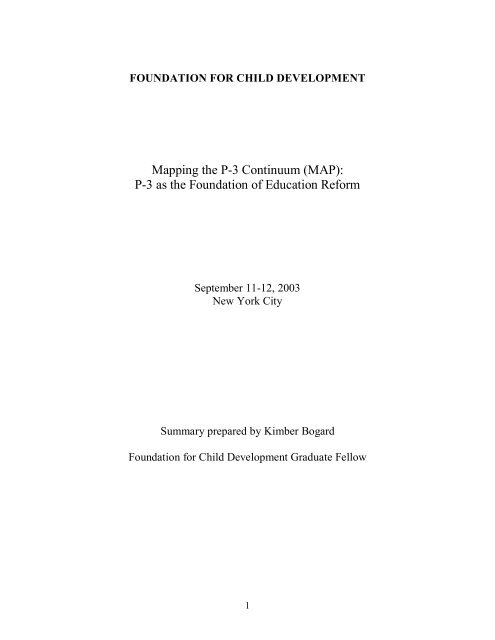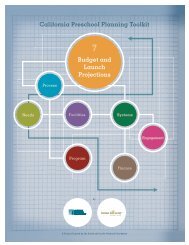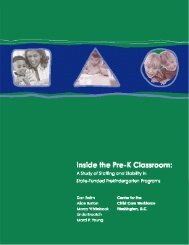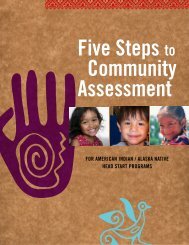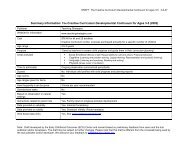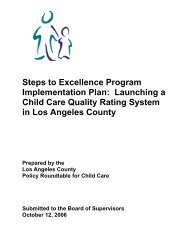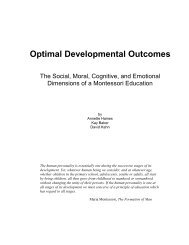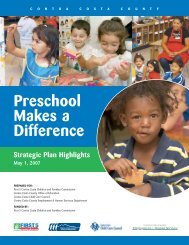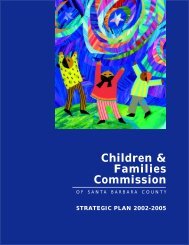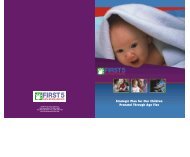Mapping the P-3 Continuum - Foundation for Child Development
Mapping the P-3 Continuum - Foundation for Child Development
Mapping the P-3 Continuum - Foundation for Child Development
You also want an ePaper? Increase the reach of your titles
YUMPU automatically turns print PDFs into web optimized ePapers that Google loves.
FOUNDATION FOR CHILD DEVELOPMENT<strong>Mapping</strong> <strong>the</strong> P-3 <strong>Continuum</strong> (MAP):P-3 as <strong>the</strong> <strong>Foundation</strong> of Education Re<strong>for</strong>mSeptember 11-12, 2003New York CitySummary prepared by Kimber Bogard<strong>Foundation</strong> <strong>for</strong> <strong>Child</strong> <strong>Development</strong> Graduate Fellow1
TABLE OF CONTENTSPageEXECUTIVE SUMMARY 3INTRODUCTION 4NEXT STEPSCRAFT A WORKING DEFINITION OF P-3 4What does P-3 mean? 4Assumptions underlying P-3 4IDENTIFY AND DOCUMENT SPECIFIC EXAMPLES OF P-3AND THEIR EFFECTS 6Four programs in <strong>the</strong> U.S. 6The French approach to P-3 8ADDRESS FINANCING AND GOVERNANCE ISSUES IN P-3 9ADDRESS THE RECRUITMENT, PREPARATION, DEVELOPMENT,AND RETENTION OF TEACHERS AND LEADERS FOR P-3 9What do P-3 classrooms look like in <strong>the</strong> U.S.? 9Teacher preparation 10SUPPORT RESEARCH ON THE EFFECTS OF P-3 ONCHILD OUTCOMES 10What we know 10What do we need to know? 11IDENTIFY KEY LEVERAGE POINTS AT THE NATIONAL, STATE,AND LOCAL LEVELS TO MOVE A P-3 AGENDA 11MARKET THE IDEA OF P-3 THROUGHSTRATEGIC COMMUNICATIONS 12WORK WITH COLLEAGUE FUNDERS ANDPOTENTIAL PARTNERS 122
EXECUTIVE SUMMARYCurrent education policy in <strong>the</strong> United States, which emphasizes high stakes testing of children,is unfair to many who do not experience an adequate education. Many children enterkindergarten on unequal footing due to variability in pre-kindergarten experiences, and, oncechildren enter kindergarten, variations in education content and quality. This variability in prekindergartenexperiences and subsequent schooling is a strong predictor of children’sachievement outcomes. These effects are even stronger <strong>for</strong> low-income children. A P-3approach aims to level <strong>the</strong> academic playing field <strong>for</strong> all children by supporting ef<strong>for</strong>ts to alignpre-kindergarten through third grade by re<strong>for</strong>ming teacher preparation and certification anddeveloping sequential learning experiences <strong>for</strong> children as <strong>the</strong>y move from pre-kindergartenthrough Grade 3.The <strong>Foundation</strong> <strong>for</strong> <strong>Child</strong> <strong>Development</strong> convened stakeholders to discuss next steps <strong>for</strong> movinga P-3 agenda <strong>for</strong>ward. A list of participants is appended to this summary. Directions <strong>for</strong> nextsteps included:1. Crafting a working definition of P-3. The definition <strong>for</strong> P-3 must include voluntary universalpre-kindergarten <strong>for</strong> children, full-day kindergarten, and alignment of both through <strong>the</strong> thirdgrade of elementary education. P-3 can be an alignment of grade levels based on developmentaland learning characteristics of children as <strong>the</strong>y proceed from pre-kindergarten through thirdgrade and including <strong>the</strong>ir after-school experiences.2. Identifying and documenting specific examples of P-3 and <strong>the</strong>ir effects on children’s learning.Examples of P-3 exist, and can in<strong>for</strong>m how to expand on current ef<strong>for</strong>ts or start up new ones.3. Addressing financing and governance issues, which include targeting sources of funds, anddeveloping plans <strong>for</strong> governance structures. One example of a well-per<strong>for</strong>ming governancestructure is that of Chicago’s <strong>Child</strong>-Parent Centers, where <strong>the</strong> program is implemented withinone administrative system, <strong>the</strong> Chicago public school system. Financing ideas can come fromplaces already implementing parts of a P-3 agenda, like Cali<strong>for</strong>nia, Georgia, and New Mexico.4. Addressing <strong>the</strong> recruitment, preparation, professional development, and retention of teachers.Participants agreed that current teacher education and credentialing are not adequately preparingteachers <strong>for</strong> <strong>the</strong> classroom.5. Identifying key leverage points. Many stakeholders, who serve different and/or overlappingconstituencies, were identified at <strong>the</strong> meeting. Engaging <strong>the</strong>se stakeholders as well as colleaguefunders will be necessary to build consensus and move <strong>the</strong> P-3 agenda <strong>for</strong>ward.6. Marketing <strong>the</strong> P-3 message. Attention must be paid to <strong>the</strong> content of <strong>the</strong> message, as well asspecific authoritative messengers. Issues raised by stakeholders who will oppose <strong>the</strong> initiativeshould be addressed. Careful attention to language and rhetoric when delivering messages willbe crucial to <strong>the</strong> effectiveness of P-3.INTRODUCTION3
Educational expectations in <strong>the</strong> United States today, as reflected by high stakes testing, do notreflect <strong>the</strong> realities of children’s classroom and learning experiences. First, <strong>the</strong>re is variability inoutcomes between children who do or do not attend pre-kindergarten and/or kindergarten.Second, systematic classroom observations reveal marked variability in classroom quality andteaching, not only between schools, but also within schools from pre-k through third grade. 1This variability has been shown to lead to different classroom experiences and outcomes <strong>for</strong>students from P-3.By providing all children with access to a pre-kindergarten education, and requiring all childrento attend kindergarten, <strong>the</strong> academic playing field <strong>for</strong> all children can be fur<strong>the</strong>r leveled.Reducing variability in classroom learning environments by providing high-quality teacherpreparation is expected to contribute to better outcomes <strong>for</strong> children. Providing opportunities <strong>for</strong>parent involvement and offering access to support services can also assist our many low-incomechildren in <strong>the</strong> educational system.CRAFT A WORKING DEFINITION OF P-3What does P-3 mean?Special attention should be paid to <strong>the</strong> language, rhetoric, and framing of <strong>the</strong> P-3 idea to clearlycommunicate <strong>the</strong> goals of a P-3 initiative.P-3 represents <strong>the</strong> potential <strong>for</strong> a well-integrated education experience <strong>for</strong> children 3-8 years old.‘P’ refers to full-day, full-year, voluntary learning experiences <strong>for</strong> all children 3-4 years old.Pre-kindergarten helps children develop <strong>the</strong> skills necessary to be successful when <strong>the</strong>y enterkindergarten. ‘P’ is aligned with kindergarten and <strong>the</strong> early school years through third grade,providing a coherent, related set of experiences <strong>for</strong> children in <strong>the</strong> first several years of publicschooling. This integrated experience would embody different developmentally appropriatepractices, based on scientific research, <strong>for</strong> children at different ages and at different grade levels.<strong>Child</strong>ren’s experiences each year are based on <strong>the</strong> attainment of skills in <strong>the</strong> previous years.It is necessary to be intentional in <strong>the</strong> curriculum with a common goal – to provide all childrenwith an equal opportunity to succeed in school. This necessitates change in <strong>the</strong> infrastructure ofour educational system, including preparation and relevant credentialing <strong>for</strong> all teachers andschool leadership and climate <strong>for</strong> sustained professional development.Assumptions underlying P-31) Focusing on each year (pre-kindergarten, kindergarten, grades 1-3) as an isolated experienceis not sufficient to reduce <strong>the</strong> likelihood of academic underachievement. Typically, preventionand/or intervention services target child care settings, pre-kindergarten, kindergarten, or <strong>the</strong> earlyelementary grades. Research shows that <strong>the</strong>re is no ‘magic bullet’, targeted at one stage of1 Pianta, R. (2003). Standardized classroom observations from pre-k to 3 rd grade: A mechanism <strong>for</strong> improvingaccess to consistently high quality classroom experiences and practices during <strong>the</strong> P-3 years. A <strong>Foundation</strong> <strong>for</strong><strong>Child</strong> <strong>Development</strong> working paper.4
development, which produces long-term outcomes <strong>for</strong> children 2 . O<strong>the</strong>r studies that haveassessed long-term outcomes of multi-year, multi-level interventions have shown that positiveeffects <strong>for</strong> children can be sustained into adulthood with economic and social benefits. 3 P-3draws from this body of research, and offers a solution that integrates currently separate entitiespre-kindergartenprograms and <strong>the</strong> K-12 public education system- serving children from agesthree to eight years.2) Under <strong>the</strong> existing K-12 educational system, achievement gaps are evident at kindergartenentry, and persist by race/ethnicity and socio-economic status through <strong>the</strong> third grade. <strong>Child</strong>rendiffer in <strong>the</strong>ir readiness to begin kindergarten, due to different experiences prior to kindergartenentry. The majority of poor readers in first grade remain poor readers in fourth grade. 43) Research points out that young children are ready to learn at birth and that children seek outstimulation to fur<strong>the</strong>r <strong>the</strong>ir own development. 5 If channeled in appropriate ways, and ifinstitutional settings are better organized to build on existing concepts and skills, children areless likely to fall through <strong>the</strong> cracks than <strong>the</strong>y are now. With developmentally appropriatescaffolding, children are more likely to flourish socially and academically. 64) The majority of <strong>the</strong> public likely supports a P-3 initiative. Particular segments of <strong>the</strong> U.S.population are dissatisfied with <strong>the</strong> current educational system’s inequities, which cause manychildren to fail academically. Evidence of this dissatisfaction can be found in state courtdecisions that have mandated education re<strong>for</strong>m (NJ, NC, OH, AR). O<strong>the</strong>r evidence can be foundin states that are adopting similar re<strong>for</strong>ms (GA, MD, MO, OR) through gubernatorial, legislative,or executive leadership. Additionally, polls in states (MA, FL) provide voter support ofuniversal pre-kindergarten.5) Research shows that variability in teaching proficiency leads to different outcomes <strong>for</strong>children. It is, <strong>the</strong>re<strong>for</strong>e, important to assess teachers’ instructional behavior in <strong>the</strong> classroomand how <strong>the</strong>y support children’s learning, in addition to evaluating children’s acquisition ofskills. Evaluations focusing on both <strong>the</strong> teacher and child will provide better in<strong>for</strong>mation toin<strong>for</strong>m interventions.2 Zigler, E., & Styfco, S. J. (1993). Head Start and Beyond: A National Plan <strong>for</strong> Extended Early Intervention. NewHaven, CT, US: Yale University Press.3 Reynolds, A., Temple, J. A., Robertson, D.L. (2001). Long-term effects of an early childhood intervention oneducational achievement and juvenile arrest: A 15-year follow-up of low-income children in public schools. JAMA:Journal of <strong>the</strong> American Medical Association, 285(18), 2339-2346.; Campbell, F.A., & Ramey, C.T. (1995).Cognitive and school outcomes <strong>for</strong> high risk African-American students at middle adolescence: Positive effects ofearly intervention. American Education Research Journal, 20, 221-236.; Comments provided by Marty Zaslowduring her presentation; Schweinehart, L.J. (1993). Significant Benefits: The High/Scope Perry Preschool StudyThrough Age 27. Ypsilanti, MI: High/Scope Press .4 Comments provided by Kristie Kauerz at <strong>the</strong> meeting: Education Commission of <strong>the</strong> States5 Piaget, J. (1948). The birth of intelligence in <strong>the</strong> child. Ox<strong>for</strong>d, England: Delachaux & Niestle6 Vygotsky, L.S., Rieber, R. W.; Hall, M. J. (1997). The collected works of L. S. Vygotsky, Vol. 4: The history of <strong>the</strong>development of higher mental functions.5
IDENTIFY AND DOCUMENT CONCRETE EXAMPLES OF P-3AND THEIR EFFECTSFour early childhood programsImportant lessons ga<strong>the</strong>red from evaluations of four extended early childhood programs <strong>for</strong> lowincomefamilies can in<strong>for</strong>m a P-3 initiative – Head Start Follow Through (1968-1996); Chicago<strong>Child</strong>-Parent Center and Expansion Program (1967-present); Carolina Abecedarian Project(1972-1985); and Head Start/Public School Early <strong>Child</strong>hood Transition Demonstration Project(1991-1998). 7 All of <strong>the</strong>se programs included parent involvement and social and health servicecomponents. Although <strong>the</strong> classroom learning environments differed in <strong>the</strong>ir curricula, allincluded some <strong>for</strong>m of ongoing staff training. Finally, all of <strong>the</strong> programs took place in anelementary school environment in kindergarten through third grade.The goal of Head Start Follow Through was to provide Head Start-like services in publicschools to ensure a smooth transition from preschool through <strong>the</strong> early grades. Due todifficulties in funding and <strong>the</strong> differences between <strong>the</strong> public schools and <strong>the</strong> service orientedprogram, Follow Through became an experiment on <strong>the</strong> effects of instructional methods on <strong>the</strong>educational development of children in kindergarten through third grade. The instructionalmethods employed in <strong>the</strong> study were 1) Direct Instruction, 2) Behavioral Analysis Models, 3)High/Scope Cognitively Oriented Curriculum Model, 4) Parent Education Model, and 5) BankStreet Model of <strong>Development</strong>al-Interaction.Two findings, in particular, are instructional <strong>for</strong> our purposes. First, <strong>the</strong> overall finding was thatinstructional method makes a difference in child outcomes, leading to enhanced educationalsuccess and social and emotional development. Both <strong>the</strong> Direct Instruction and BehavioralAnalysis Models showed stronger effects than <strong>the</strong> High/Scope Cognitively Oriented CurriculumModel, Parent Education Model, and <strong>the</strong> Bank Street Model of <strong>Development</strong>al-Interaction.Second, <strong>the</strong>re was variation in program effectiveness across schools, which was larger than <strong>the</strong>variations among <strong>the</strong> different methods of instruction. This later finding illuminates <strong>the</strong> problemof standardized implementation across schools.The Chicago <strong>Child</strong>-Parent Center and Expansion Program (CPC) is <strong>the</strong> oldest extendedearly childhood intervention, and <strong>the</strong> second oldest federally funded preschool program in <strong>the</strong>U.S. (Head Start is <strong>the</strong> oldest). The program seeks to promote urban low-income, AfricanAmerican and Hispanic children’s academic success and to increase parent involvement. Oneimportant and unique component of <strong>the</strong> CPC program is its central governance through <strong>the</strong>Chicago Public School System, including oversight by <strong>the</strong> school principal. O<strong>the</strong>r componentsinclude pre-school <strong>for</strong> all three-year-olds, parent resource rooms, and reduced class sizes (from35+ to 25). The curriculum focuses on basic skill attainment. Strong parental involvement and<strong>the</strong> provision of follow-on services are equally integral components of <strong>the</strong> program.Essential findings from CPC evaluations include: 1) <strong>Child</strong>ren who participated <strong>for</strong> four or moreyears had higher reading and math achievement in eighth grade, as well as higher rates of7 Reynolds, A. (2003). Key characteristics and implications of working models: Chicago <strong>Child</strong>-Parent Centers.Presentation at <strong>Foundation</strong> <strong>for</strong> <strong>Child</strong> <strong>Development</strong>.6
graduation, as compared to children with no participation; 2) participation beyond kindergartenshowed more successful outcomes <strong>for</strong> children; 3) participants who were in <strong>the</strong> program throughthird grade versus those who stopped in second grade had more successful outcomes through 15years old, particularly lower rates of grade retention and need <strong>for</strong> special education services; 4)delinquency at ages 13-15 years and school dropout rates were also found to be less <strong>for</strong> extendedprogram participants than <strong>for</strong> shorter term participants.The goal of <strong>the</strong> Carolina Abecedarian Project (ABC) was to reduce academic failure in lowincome,rural children. Educational child care was provided to mainly African-Americanchildren beginning at 4 months old through 5 years old. This early intervention was followed bythree years of continued intervention through second grade. Components of <strong>the</strong> earlyintervention included language and literacy skills, low child-to-teacher ratios, and familysupport. The school-age program also included a six-week summer transition prior tokindergarten entry.Key findings are: 1) Extended participation past <strong>the</strong> pre-school component produced higherachievement; and 2) at <strong>the</strong> 15-year-follow-up, <strong>the</strong> extended participation group exceeded <strong>the</strong>non-extended group only in reading achievement, but not math achievement, IQ test scores,grade retention, or special education.The National Head Start/Public School Early <strong>Child</strong>hood Transition Demonstration Project(HST) was implemented in school districts across <strong>the</strong> country beginning in 1991, with federalfunding. This was an attempt to implement <strong>the</strong> original goals of Follow Through. Specifically,<strong>the</strong> goals were to coordinate Head Start and elementary school programs to providecomprehensive support services and encourage parent involvement. In contrast with FT, HSTfocused more on support services and less on instructional activities.Research findings across sites were mixed, and inconsistent. Some sites found no effect,whereas o<strong>the</strong>rs found a positive effect <strong>for</strong> parent involvement on achievement scores in <strong>the</strong> thirdgrade. Ano<strong>the</strong>r site noted positive effects on social skills in <strong>the</strong> first and second grades, as wellas higher parent involvement.SummaryIn summary, both <strong>the</strong> CPC and ABC programs provide evidence that extended early childhoodprograms can promote future school success in disadvantaged populations. The differences in<strong>the</strong> long-term effects between <strong>the</strong> two programs may reflect <strong>the</strong> differences in <strong>the</strong> programs<strong>the</strong>mselves. In particular, <strong>the</strong> ages of <strong>the</strong> participating children differed. ABC children began<strong>the</strong> program at 4 months and continued through second grade, and <strong>the</strong> CPC children began at 3-years of age and continued through third grade. It has been noted elsewhere that <strong>the</strong> third gradeis an important transition grade <strong>for</strong> children 8 , and should perhaps be included in a program thatwants to impact educational outcomes. Additionally, <strong>the</strong> educational contexts were different <strong>for</strong><strong>the</strong>se two groups of kids. CPC children were living in economically disadvantaged, mostlyminority neighborhoods, whereas <strong>the</strong> ABC children attended school in a rural area of NorthCarolina with mostly white middle-class children. Ano<strong>the</strong>r difference between <strong>the</strong> two programs8 Stipek, D. (2002). At what age should children enter kindergarten? A question policymakers and parents. SocialPolicy Report, 16 @), 3-16.7
is that CPC classes had a higher teacher-to-child ratio, as well as teacher aides, whereas ABCchildren were in <strong>the</strong> traditional classroom setting.The lessons learned from <strong>the</strong>se evaluation studies include:• The importance of a single delivery system <strong>for</strong> both <strong>the</strong> early and extended interventions• Reduced class sizes• Coordinated instructional delivery• A focus on school readiness in <strong>the</strong> early years• Building on that readiness in <strong>the</strong> subsequent years leads to smoo<strong>the</strong>r transitions andhigher rates of success in school <strong>for</strong> children• The duration of program participation is essential to long-term outcomes includingreduced dropout rates, grade retention, delinquency, and higher academic successIn short, a well-coordinated system with <strong>the</strong> goals of improving school outcomes and increasingparent involvement, as well as providing necessary support services over a number of years,constitute key lessons learned from <strong>the</strong>se evaluation studies.The French system of educationThe French-American <strong>Foundation</strong> 9 reports that in France, pre-kindergarten <strong>for</strong> all three-, four-,and five-year old children is a way to welcome children into French society. Beginning at threeyears of age, <strong>the</strong> French consider it normative <strong>for</strong> all children to enter <strong>the</strong> ecole maternelle. Itspurpose is not considered an intervention only <strong>for</strong> low-income and immigrant children, but anopportunity <strong>for</strong> all children.The French education system is an example of an integrated and intentional public educationsystem <strong>for</strong> all French children ages 3-18 years old. The curriculum was established by <strong>the</strong>French Ministry of Education, and is followed by every public school teacher. The goals andoutcomes of <strong>the</strong> curriculum are explicit, and teachers as well as children are expected to follow<strong>the</strong> established curriculum. The curriculum drives every activity that children are involved within <strong>the</strong> classroom. Highly trained teachers manage to implement <strong>the</strong> curriculum in creative waysto engage every child. The classroom environment is structured in a way that enables children topractice <strong>the</strong> skills that are expected of <strong>the</strong>m from year to year.In ano<strong>the</strong>r report by <strong>the</strong> French-American <strong>Foundation</strong>, 10 researchers devised a list of elementsthat make <strong>the</strong> education system in France one approach to P-3 from which <strong>the</strong> U.S. can learn.First, voluntary, free pre-kindergarten is available to all children beginning at two years of age.Although only 35% of two year olds attend preschool, almost all three-, four-, and five-year-oldsattend. Second, <strong>the</strong> quality standards <strong>for</strong> teachers and classroom curricula are high in France.Third, 10 percent more money is spent on children located in disadvantaged areas. Theseresources are used to reduce class size, reward teachers with bonuses, hire specialists, anddevelop community partnerships. Fourth, <strong>the</strong> French believe that early entry to <strong>the</strong> educationsystem helps children in <strong>the</strong> long run by increasing <strong>the</strong>ir linguistic, cognitive, social, andphysical skills. Fifth, <strong>the</strong> school system integrates children from immigrant backgrounds into <strong>the</strong>9 Cooper, C.J. (2002). Ready to learn: The French system of early education and care offers lessons <strong>for</strong> <strong>the</strong> UnitedStates. A report of <strong>the</strong> French-American <strong>Foundation</strong>.10 Neuman, M. J., & Peer, S. (2002). Equal from <strong>the</strong> start: Promoting educational opportunity <strong>for</strong> all preschoolchildren-Learning from <strong>the</strong> French experience. A report of <strong>the</strong> French-American <strong>Foundation</strong>.8
French school system through immersion in French language and culture, while valuing andencouraging <strong>the</strong> retention of <strong>the</strong> child’s native language and culture in <strong>the</strong> home. It is importantto note that <strong>the</strong> French education system is embedded in social policies that support all childrenand families, including essential health and social services.ADDRESS FINANCING AND GOVERNANCE ISSUES IN P-3Sources <strong>for</strong> funding P-3 are related to <strong>the</strong> geographic location of implementation (e.g., localschool district, citywide, or statewide). One suggestion is to start small and developincrementally. Ano<strong>the</strong>r idea is to identify places where <strong>the</strong>re is an openness to try new things.Whereas cost is currently a barrier to pre-kindergarten in many states, <strong>the</strong>re are some states usingcreative ways to go <strong>for</strong>ward with a universal pre-k agenda. Georgia has enacted universal prekindergarten<strong>for</strong> all four-year-olds through state lottery. New Mexico has recently implementedfull-day kindergarten through state financing. Now that <strong>the</strong>se states have some elements of P-3,<strong>the</strong>y may consider alignment.ADDRESS THE RECRUITMENT, PREPARATION, DEVELOPMENT, ANDRETENTION OF TEACHERS AND LEADERS FOR P-3What do P-3 classrooms look like in <strong>the</strong> U.S.?In analyzing systematic observations of over 240 pre-kindergarten classrooms in six states, 223kindergarten classrooms in three states, over 900 first-grade classrooms, and over 800 thirdgradeclassrooms in more than 35 states, Pianta and colleagues found great variability inclassroom quality across schools, across grades, and within schools. 11 The CLASS was <strong>the</strong>assessment instrument that measured social-emotional climate (e.g., teacher sensitivity, behaviormanagement), instructional climate (e.g., productivity, concept development, learning <strong>for</strong>mats,basic skill activities, scaffolding, constructive feedback), and quality of interactions betweenteachers and students (e.g., whole group versus small group work, individual interactionsbetween child and teacher). Variability in classroom quality was not related to teacher educationor class size. This finding suggests that teacher preparation and <strong>the</strong>ir behavior in <strong>the</strong> classroomare not well-aligned at this time.Whereas Pianta and colleagues are beginning to assess <strong>the</strong> relationships between classroomquality and child outcomes, some preliminary analyses show that variability is associated withachievement, emotional, and behavioral outcomes <strong>for</strong> children. Three constructs that assessed <strong>the</strong>social-emotional climate and quality of teacher-child interactions predicted: 1) children’sper<strong>for</strong>mance on standardized tests of literacy skill in pre-kindergarten and first grade; 2) lowerlevels of mo<strong>the</strong>r reports of internalizing behaviors in kindergarten and first grade; and 3)children’s engagement in <strong>the</strong> classroom across all grade levels. The richness of <strong>the</strong> instructionalenvironment from pre-kindergarten to third grade, characterized by teachers promoting higherorder thinking and problem solving, facilitation of activities, and quality of feedback (e.g.,scaffolding) predicted <strong>the</strong> academic functioning of <strong>the</strong> child. Results of quality classroomenvironments were stronger <strong>for</strong> children from a low socioeconomic background than children11 Pianta, R. (2003). Standardized classroom observations from pre-k to 3 rd grade: A mechanism <strong>for</strong> improvingaccess to consistently high quality classroom experiences and practices during <strong>the</strong> P-3 years. A <strong>Foundation</strong> <strong>for</strong><strong>Child</strong> <strong>Development</strong> working paper.9
from a high socioeconomic background. These initial findings suggest <strong>the</strong> potential positiveeffects of classroom quality on child outcomes, especially <strong>for</strong> economically disadvantagedchildren.Teacher preparationEvidence that teacher education was unrelated to classroom quality signals a need to examineteacher education. The National Research Council report Eager to Learn emphasized <strong>the</strong>“unexpected competencies” of young children and questioned current beliefs about ways toeducate young children. Teachers interviewed by Pianta reported that <strong>the</strong>y did not feel <strong>the</strong>irpreparation adequately prepared <strong>the</strong>m <strong>for</strong> <strong>the</strong> classroom. Struggling to do a good job, lack ofsupport, and wanting to improve <strong>the</strong>ir per<strong>for</strong>mance were also expressed by teachers ininterviews. These views reflect <strong>the</strong> inadequacy of teacher preparation and <strong>the</strong> lack of support <strong>for</strong>professional development once <strong>the</strong>y are in <strong>the</strong> classrooms.Requirements <strong>for</strong> teacher credentialing vary by state, with even more variability <strong>for</strong> earlychildhood educators. With <strong>the</strong> advent of high stakes testing in <strong>the</strong> U.S., how teachers areprepared to impart knowledge to children is an important area worth investigating. Whereas <strong>the</strong>current focus is on assessing children’s attainment of specific types of knowledge, <strong>the</strong> solutionmight include assessing <strong>the</strong> capacity of teachers to impart this knowledge to children.Teacher education should be intentional, with specific guidelines and goals, which are alignedwith expectations <strong>for</strong> learning by children as well as <strong>the</strong>ir developmental capabilities. Highstandards should be maintained <strong>for</strong> all levels of teachers, from pre-kindergarten to third grade.An important focus must be placed on preparing teachers to work with children and familiesfrom different cultures. Teachers should be trained to be culturally competent in <strong>the</strong> classroomand to work with families of culturally diverse children.A newly developed teacher preparation system, based on developmental and educationalresearch, could be implemented and evaluated. In turn, this could become a model <strong>for</strong> teacherpreparation on a larger scale.SUPPORT RELEVANT RESEARCH ON THE EFFECTS OF P-3 ON CHILDOUTCOMESWhat we knowProgram evaluation studies provide evidence that systematic changes in early and elementaryeducation can lead to positive child achievement outcomes if implemented over several years.O<strong>the</strong>r program evaluations show that one-year interventions do not result in long-term outcomes<strong>for</strong> children. Timing is ano<strong>the</strong>r important element in program implementation that has beenshown to affect child outcomes. Early and middle childhood periods are important <strong>for</strong> positivestatus during early adulthood, and interventions targeting multiple years in both of <strong>the</strong>se periodswill have a stronger impact than ei<strong>the</strong>r one alone. 1212 Zaslow, M. (2003). What can we learn from developmental research about how to support children’s learningfrom age three to age eight? Presentation to a <strong>Foundation</strong> <strong>for</strong> <strong>Child</strong> <strong>Development</strong> Meeting on P-3.10
Transitions can be considered periods of risk in development. <strong>Child</strong>ren who do not makesuccessful transitions may be at increased risk <strong>for</strong> poor outcomes. For example, research showsthat many school environments are not conducive to adaptive outcomes <strong>for</strong> adolescents. Thetransition from elementary school to junior high or middle school can be a risk period <strong>for</strong>academic decline <strong>for</strong> many youth. 13 The transition from <strong>the</strong> summer to <strong>the</strong> academic year isano<strong>the</strong>r risk period, especially <strong>for</strong> economically disadvantaged children. 14 Whereas <strong>the</strong>re werelittle differences between children in ten low-SES schools as compared to kids in 10 high-SESschools during <strong>the</strong> first grade transition from kindergarten, gaps grew as children got older. Theauthors concluded that this finding was due to “summer loss.” Summer loss is <strong>the</strong> process bywhich children lose skills and in<strong>for</strong>mation learned <strong>the</strong> school year be<strong>for</strong>e, because of <strong>the</strong> lack ofexposure to educationally stimulating activities during <strong>the</strong> summer vacation.In sum, what happens in <strong>the</strong> classroom matters <strong>for</strong> children, and current credentialingrequirements <strong>for</strong> teachers are not necessarily a good indicator of <strong>the</strong> effectiveness of <strong>the</strong>irteaching. Research shows that what happens in <strong>the</strong> classroom does influence cognitive,behavioral, and emotional outcomes. 15 Teacher credentials, on <strong>the</strong> o<strong>the</strong>r hand, were notpredictive of child outcomes. In addition, research shows <strong>the</strong> potential risk that transitionperiods can have <strong>for</strong> children, especially those who are economically disadvantaged.What do we need to know?We still need to know to what extent, and how different classroom contexts influence childoutcomes across ages/grades, and <strong>for</strong> diverse groups of children. We also need to know whatsound teacher preparation looks like and how it is linked with desired child outcomes.IDENTIFY KEY LEVERAGE POINTS AT THE NATIONAL, STATE, AND LOCALLEVELS TO MOVE A P-3 AGENDAParticipants generated a list of key stakeholders <strong>for</strong> P-3:• Higher education institutions who train teachers and administratorso AACTE – American Association of Colleges <strong>for</strong> Teacher Education• National Board <strong>for</strong> Professional Teaching Standards• American Federation of Teachers and National Education Association• NAEYC - National Association <strong>for</strong> <strong>the</strong> Education of Young <strong>Child</strong>ren• CDA – <strong>Child</strong> <strong>Development</strong> Associate• ACCES – Alliance of Community Colleges <strong>for</strong> Electronic Sharing• NASBE – National Association of State Boards of Education• NABE – National Association <strong>for</strong> Bilingual Education• NGA – National Governors Association13 Zaslow, M. (2003). What can we learn from developmental research about how to support children’s learningfrom age three to age eight? Presentation <strong>Foundation</strong> <strong>for</strong> <strong>Child</strong> <strong>Development</strong>14 Zaslow, M. (2003). What can we learn from developmental research about how to support children’s learningfrom age three to age eight? Presentation <strong>Foundation</strong> <strong>for</strong> <strong>Child</strong> <strong>Development</strong>15 Pianta, R. (2003). Standardized classroom observations from pre-k to 3 rd grade: A mechanism <strong>for</strong> improvingaccess to consistently high quality classroom experiences and practices during <strong>the</strong> P-3 years. A <strong>Foundation</strong> <strong>for</strong><strong>Child</strong> <strong>Development</strong> working paper11
• National Conference of Mayors• CED – Committee on Economic <strong>Development</strong>• NBCDI - National Black <strong>Child</strong> <strong>Development</strong> Institute• National Chamber of Commerce• CCSSO – Council of Chief State School Officers• Think tanks to re-develop credentialing standards• National Head Start Association• National Association of Elementary School Principals• Consensus organizations to build on, and influence public will to improve <strong>the</strong>educational system• Parents• School re<strong>for</strong>mers• Community-based organizations and representatives from communitiesAn analysis of <strong>the</strong>se stakeholders’ needs and constituencies including <strong>the</strong>ir competing agendaswill be necessary to <strong>for</strong>ge consensus among <strong>the</strong>se groups.MARKET THE IDEA OF P-3 THROUGH STRATEGIC COMMUNICATIONS1) Message development – What is <strong>the</strong> message? Attention should be directed toward languageand rhetoric in <strong>the</strong> <strong>for</strong>mulation of messages. They should be integrated into education re<strong>for</strong>m,linked to community organizations, and tied into public health issues. P-3 is part of universalpre-k, but also inclusive of, and related to, after-school activities <strong>for</strong> children. P-3 as systemsrestructuring and not add-on services or intervention services, should be articulated.2) How to market <strong>the</strong> message? Increasing public understanding of P-3 and combatingresistance to change are integral to message effectiveness. One suggestion of how to market <strong>the</strong>message of P-3 is through social integration, similar to <strong>the</strong> French. The French Ministry ofEducation believes that pre-kindergarten is a critical element toward citizenship in France.3) Who delivers <strong>the</strong> message? Selection of messengers should take into account credentials andcredibility in relation to key audiences and stakeholders.WORK WITH COLLEAGUE FUNDERS AND POTENTIAL PARTNERSWorking with colleague funders and potential partners will be important to move <strong>the</strong> P-3 agenda<strong>for</strong>ward. Since P-3 is a large, systematic, structural initiative, <strong>the</strong> <strong>Foundation</strong> <strong>for</strong> <strong>Child</strong><strong>Development</strong> requires partners. It will be necessary to work with colleague funders to assemble<strong>the</strong> resources necessary to fund <strong>the</strong> initiative. Forming partnerships with key stakeholders isimportant to build <strong>the</strong> consensus necessary to make P-3 a reality. Both colleague funders andpotential partners will help shape P-3 through <strong>the</strong>ir insight and involvement.12
First Things First: P-3 as <strong>the</strong> <strong>Foundation</strong>of Education Re<strong>for</strong>mParticipant List<strong>Foundation</strong> For <strong>Child</strong> <strong>Development</strong>September 11 — 12, 2003Ruth Ann BurnsPresidentThe Burns Group11 Beechwood DriveManalapan, NJ 07726Tel: 732-683-9724Fax: 732-683-9725raburns@ optonline.netRichard Clif<strong>for</strong>dSenior Scientist/ Co-Director, National Center<strong>for</strong> E arly <strong>Development</strong> and Learning: Co-Director, National Prd-Kindergarten CenterUniversity of North Carolina at Chapel HillFPG <strong>Child</strong> <strong>Development</strong> InstituteCB No. 8040Chapel Hill, NC 27599-8040Tel: 919_962-4734Clif<strong>for</strong>d@ mail.fpg.unc.eduAnthony J. ColónVice PresidentCenter <strong>for</strong> Community E ducational ExcellenceNational Council of La Raza1111 19 th Street, NW, Ste. 1000Washington, DC 20036Tel: 202-776-1736Fax: 202-776-1792acolon@ nclr.orgStephanie FanjulDirector of Student Achievement ProgramNational E ducation Association1201 16 th Street, NWWashington, DC 20036Tel: 202-822-7946sfanjul@ nea.orgArthur GreenbergProfessorNew York UniversitySchool of E ducation239 Greene Street, Room 303New York, NY 10003Tel: 212-998-5177Fax: 212-995-4047arthur.greenberg@ nyu.eduJanet H ansenVice President and Director of E ducation StudiesCommittee <strong>for</strong> E conomic <strong>Development</strong>2000 L Street, NW, Suite 700Washington, DC 20009Tel: 202-296-5860Mariana HaynesDirector of ResearchNational Association of State Boards ofEducation277 South Washington Street, Suite 100Alexandria, VA 22314Tel: 703-684-4000 ext. 122marianah@ nasbe.orgSharon Lynn KaganVirginia & Leonard Marx ProfessorOf E arly <strong>Child</strong>hood & Family PolicyCo-Director, Center <strong>for</strong> <strong>Child</strong>ren & FamiliesTeachers College, Columbia UniversityBox 226, Room 371 GDH525 West 120 th StreetNew York, NY 10027-6696Tel: 212-678-8255Sharon.kagan@ columbia.edu13
Kristie KauerzProgram Director, Early <strong>Child</strong>hoodEducation Commission of <strong>the</strong> States700 Broadway, #1200Denver, CO 80203-3460Tel: 303-299-3662E-mail: kkauerz@ecs.orgRobert PiantaWilliam Clay Parrish ProfessorCurry School of EducationUniversity of VirginiaP O Box 800784Charlottesville, VA 22904-8784Tel: 434-243-5483E-mail: rcp4p@virginia.eduAisha RayDirector, Bilingual/ESL-Multicultural TeacherEducation ProgramErikson Institute420 North Wabash Avenue, 6 th FloorChicago, IL 60611Tel: 312-755-2250 ext. 7137array@ erikson.eduArthur ReynoldsProfessorWaisman Center, University of Wisconsin1500 Highland Avenue, Rm. 538AMadison, WI 53705Tel: 608-263-1847areynolds@ waisman.wisc.eduJeanne ShaheenThe Honorable Jeanne ShaheenFormer Governor of New HampshireRichard TagleSenior Associate, School & CommunityPublic E ducation Network601 Thirteen Street, NS, Suite 900 NorthWashington, DC 20005Tel: 202-628-7460rtagle@ publiceducation.orgAmy WilkinsE xecutive DirectorTrust <strong>for</strong> E arly E ducation, Inc.1725 K Street, Suite 212Washington, DC 20006Tel: 202-293-1245 ext. 296awilkins@ trust<strong>for</strong>earlyed.orgMartha ZaslowAssistant Director of Research<strong>Child</strong> Trends, Inc.4301 Connecticut Avenue, Suite 100Washington, DC 20008Tel: 202-362-5580mzaslow@ childtrends.org<strong>Foundation</strong> <strong>for</strong> <strong>Child</strong> <strong>Development</strong>Ruby TakanishiFasaha TraylorAnnette ChinMark BogosianKimber BogardAlyssa Rayman-ReadSteve SuittsProgram CoordinatorSou<strong>the</strong>rn E ducation <strong>Foundation</strong>135 Auburn Avenue, 2 nd FloorAtlanta, GA 30303Tel: 404-523-0001suitts@ attglobal.net14


